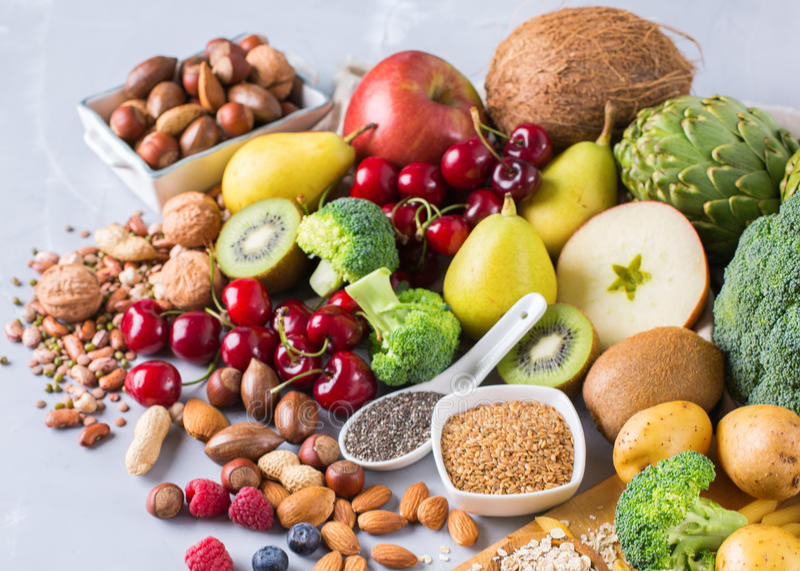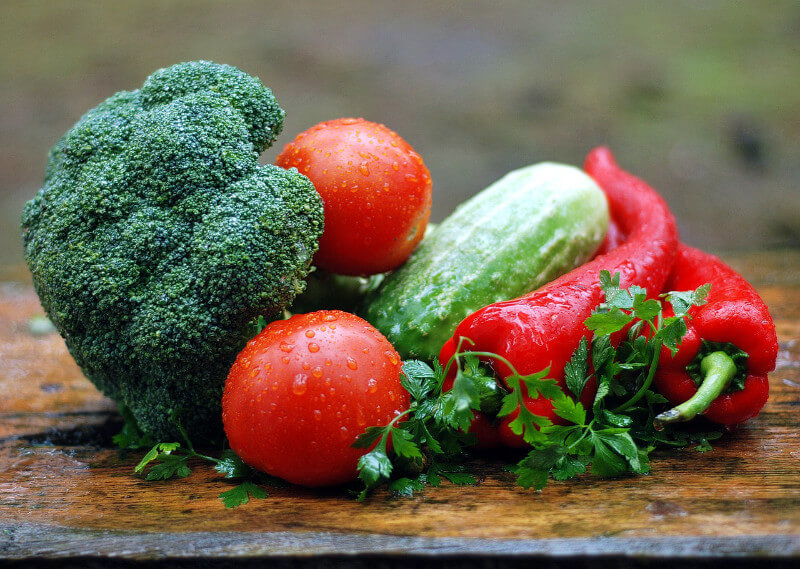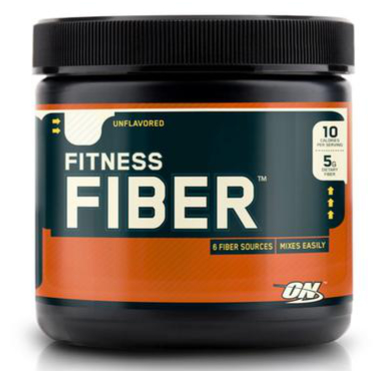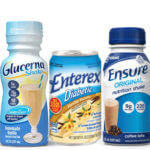Dietary Fiber – Benefits for Diabetes, Weight Loss and Heart Health

Whether it’s for weight loss, diabetes management and blood sugar control, or heart health, dietary fiber is a great way to improve your overall health. Different types of dietary fiber affect the body in various ways and can be used to improve specific areas. Despite the apparent simplicity, fiber is a complex nutrient and all types are important.
Fiber is a non digestible carbohydrate found in plants. Any food that is plant based will contain fiber. Foods that are derived from animal sources such as meat, dairy products and fats do not contain fiber. In order to get the benefits of all the different types of this nutrient it’s best to consume a variety of vegetables, fruits, some cereals, beans and whole grains.
Unlike table sugar, fiber is made up of many little units of sugar linked together into chains that cannot be unravelled hence non digestible by our body. If it cannot be digested then it cannot be used for energy. Dietary fiber is broadly classified into soluble and insoluble fiber.
Soluble Fiber

Soluble fiber turns into a gel when mixed with water in the gastrointestinal tract. It is fermented in the colon, and plays a role in slowing the absorption of glucose into the bloodstream. It also encourages the growth of the ‘friendly’ bacteria that help break down bile, and are involved in the creation of B vitamins like folic acid, niacin, and pyridoxine. Sources of this type of fiber include oatmeal, nuts, seeds and lentils.
Insoluble Fiber

Insoluble fiber on the other hand, acts a bit like an intestinal broom. This is the type of fiber that keeps you ‘regular’, and helps prevent issues such as hemorrhoids, diverticulitis and constipation. One major benefit of insoluble fiber is that it provides a feeling of fullness. This makes it a great ally in weight loss, hunger control and blood sugar stability. If you are carbohydrate counting you will need to subtract fiber from the total grams of carbohydrates because it doesn’t affect blood sugar levels. Insoluble fiber can be found in wheat bran, vegetables and whole grains.
The Differences Between Soluble and Insoluble Fiber
| Soluble Fiber | Insoluble Fiber |
|---|---|
| Dissolves in water and is partially absorbed into the bloodstream through the lower digestive tract. | Does not dissolve in water and is not readily absorbed by the body. |
| Lowers blood cholesterol levels by preventing absorption of cholesterol like particles in the digestive tract. | Promotes regularity and helps bowel function. |
| Prolongs digestion providing energy over longer spans of time. | Stimulates smooth efficient movement of food throughout the digestive system. |
| Found in oats, beans and other legumes, barley and some fruits. | Found in wheat bran, whole-grain products, most vegetables and fruits. |
Fiber and Glycemic Index
The idea is to try to include more low gylcemic index foods in your diet. The glycemic index measures how quickly carbohydrate within food is released into the body. Some carbohydrates are released into the body quickly while others are released more slowly. According to the International GI Database, foods with a GI value of 55 and under contain slow-releasing carbohydrates and are classed as low GI. Medium GI foods are valued between 56 and 69 while high GI foods have a value of 70 or above. You will notice that many low glycemic index foods are in fact high in fiber. Foods with a high glycemic index cause blood sugar levels to spike.
Low glycemic index foods include lentils, chickpeas, baked beans, fruit loaf, salmon sushi, barley, milk, low fat custard, soy milk, yoghurt, apples, strawberries, grapes, spaghetti, peas, carrots, and chocolate milk.
Moderate glycemic index foods include pea soup, rye bread, porridge, muesli, ice cream, bananas, pineapple, kiwi fruit, new potatoes, beetroot, white sugar, honey, and mars bars.
High glycemic index foods include broad beans, bagels, white bread, brown rice, watermelon, udon noodles, desiree, pontiac and sebago potatoes, and glucose.
More Fiber Will Help Improve Blood Sugar Levels and Overall Health

We need both soluble and insoluble fiber. A study published in the American Journal of Clinical Nutrition found that in a group of 6000 French men and women, those with the highest levels of soluble and insoluble fiber in their diet had a lower risk of being overweight, a lower risk of having blood pressure problems, cholesterol problems, and they had better levels of triacylglycerols and homocysteine. The last two are measure3 of heart health.
Fiber from cereals was linked to lower body fat, lower blood pressure, and lower levels of homocysteine. My go to cereal is Kellogg’s All Bran. It contains a a total of 10 grams per serving which equates to 40% of the average total recommended daily amount of fiber. When I subtract the fiber from the total carbohydrates I am left with only 13 grams that will actually affect my blood sugar. The absorption of these carbs are also slowed by the fiber which mean I will not get a spike in my blood sugar level.
Those with a higher intake of vegetables, also a source of fiber, had lower blood pressure and lower homocysteine levels. Fiber from fresh fruit was associated with a lower waist to hip ratio (good news for dieters!), and lower blood pressure. And fiber from dried fruit, nuts, and seeds (like sesame seeds, sunflower seeds, and pumpkin seeds) was also linked to a lower waist to hip ratio, lower body fat, and a better fasting glucose concentration. Fasting glucose relates to having a steady level of glucose between meals. If it dips too low, we crave things, often sweets.
Fiber has another interesting benefit. In people with type 2 diabetes, it has been found to lower the levels of ‘bad’ cholesterol, and increase the levels of ‘good’ cholesterol. It has already been established that fiber supplements will lower the levels of bad cholesterol in people, whether they have diabetes or not.
Achieving a High Fiber Diet
As you can see, fiber has many amazing health benefits. Remember that adults need between 21 to 38 grams of fiber per day from both soluble and insoluble sources. You should also increase your fiber intake gradually instead of making a drastic change. Here are a couple ways to easily increase your daily fiber intake and reap all the associated health benefits.
- Have oatmeal or another whole-grain cereal for breakfast.
- Choose whole-grain breads, corn tortillas, corn bread, rye bread, pumpernickel bread or rye bread instead of white bread.
- Eat brown rice instead of white rice.
- Eat more vegetables beyond salad greens. Eat broccoli, carrots, cauliflower, cabbage, zucchini and green beans.
- Eat fresh fruits (unpeeled when possible) rather than drinking fruit juices or canned fruits.
 If you are struggling to meet this requirement from your daily meals I suggest adding a fiber supplement to your nutrition plan. They are relatively cheap and will help you achieve many of the aforementioned benefits.
If you are struggling to meet this requirement from your daily meals I suggest adding a fiber supplement to your nutrition plan. They are relatively cheap and will help you achieve many of the aforementioned benefits.
Fiber Content of Commonly Eaten Foods
| Food | Serving Size | Soluble Fiber (grams) | Insoluble Fiber (grams) | Total Fiber (grams) |
|---|---|---|---|---|
| Grains | ||||
| Barley, pearled, cooked | 1/2 cup | 1.2 | 2.7 | 3.9 |
| White bread | 1 slice | 0.2 | 0.6 | 0.8 |
| Whole wheat bread | 1 slice | 0.3 | 2.2 | 2.5 |
| Corn bread | 2 1/2 ” square | 0.2 | 2.1 | 2.3 |
| Oat bran, uncooked | 1/2 cup dry | 3.0 | 5.0 | 8.0 |
| Oatmeal, cooked | 1 cup | 1.9 | 1.8 | 3.7 |
| Brown rice, cooked | 1/3 cup | 0 | 0.6 | 0.6 |
| White rice, cooked | 1/3 cup | 0 | 0.2 | 0.2 |
| Shredded Wheat | 1 biscuit | 0.3 | 2.4 | 2.7 |
| Pasta | 1/2 cup | 0.2 | 0.8 | 1.0 |
| Wheat bran, All-bran | 1/2 cup | 1.0 | 11.0 | 12.0 |
| Fruits | ||||
| Apple with skin | 1 small | 0.4 | 2.6 | 3.0 |
| Banana | 1 small | 0.5 | 1.3 | 1.8 |
| Cantalope | 1 cup | 0.2 | 1.0 | 1.2 |
| Orange | 1 small | 0.5 | 1.7 | 2.2 |
| Grapes | 17 small | 0 | 0.8 | 0.8 |
| Peach with skin | 1 medium | 1.0 | 2.0 | 3.0 |
| Pear with skin | 1 medium | 0.7 | 3.9 | 4.6 |
| Grapefruit, peeled | 1/2 medium | 0.3 | 1.1 | 1.4 |
| Strawberries | 1 1/4 cups | 0.8 | 2.5 | 3.3 |
| Vegetables | ||||
| Broccoli, cooked | 1/2 cup | 0.2 | 1.7 | 1.9 |
| Carrots, raw or cooked | 1 medium or 1/2 cup | 0.4 | 1.5 | 1.9 |
| Cauliflower, cooked | 1/2 cup | 0.2 | 1.0 | 1.2 |
| Corn. whole-kernel cooked | 1/2 cup | 0.1 | 1.5 | 1.6 |
| Green beans, drained | 1/2 cup | 0.3 | 1.2 | 1.5 |
| Potato, baked with skin | 1 small (3oz) | 0.5 | 1.5 | 2.0 |
| Tomato, raw | 1 average | 0.2 | 0.6 | 0.8 |
| Lettuce, leaf or iceberg | 1cup, shredded | 0 | 0.7 | 0.7 |
| Vegetables | ||||
| Black-eyed peas, cooked | 1/2 cup | 0.2 | 2.3 | 2.5 |
| Kidney beans, cooked | 1/2 cup | 1.0 | 3.5 | 4.5 |
| Lima Beans, cooked | 2/3 cup | 0.7 | 3.9 | 4.6 |
| Green peas, cooked | 1/2 cup | 0.3 | 2.8 | 3.1 |
| Pinto beans, cooked | 1/2 cup | 0.2 | 2.9 | 3.1 |
| Great Northern beans, cooked | 1/2 cup | 0.3 | 7.9 | 8.2 |
From the table above you can create a nutrition plan with several of these food items to increase your fiber intake and reap its benefits. Adding more vegetables and legumes to your lunch, swapping white rice for brown rice, swapping white bread for whole wheat bread, eating more fruit and even adding oatmeal to your breakfast can definitely do the trick.
The Complete List of Dietary Fiber benefits
- Normalizes bowel movements
- Helps Maintain bowel health
- Lower the risk of hemorrhoids
- Have healthier gut bacteria
- Increases mineral absorption
- Improves digestive health
- Improves short-chain fatty acid production
- Reduces risk of diverticulitis
- Lowers cholesterol levels
- Decrease type 2 diabetes risk
- Increased insulin sensitivity
- Helps control blood sugar levels
- Aids in achieving healthy weight
- Helps you feel fuller
- Lower your odds of heart disease
- Reduces your risk of certain cancers
- Have healthier bones
- Promotes skin health
- May reduce the risk of gallstones and kidney stones
- Increases immune system support
- Live longer, Period.





 My name is Christopher and I am a type 1 diabetic. I was diagnosed at age 6 in 1993 and with good management I have been healthy and complication free to date. Like most persons living with type 1 diabetes, I have had my ups and downs, daily struggles and issues. However, I intend to live my life to the fullest and I will not let diabetes get in my way.
My name is Christopher and I am a type 1 diabetic. I was diagnosed at age 6 in 1993 and with good management I have been healthy and complication free to date. Like most persons living with type 1 diabetes, I have had my ups and downs, daily struggles and issues. However, I intend to live my life to the fullest and I will not let diabetes get in my way.




Leave a Reply
4 Comments on "Dietary Fiber – Benefits for Diabetes, Weight Loss and Heart Health"
[…] Fiber is a type of carbohydrate. However, because the human body cannot digest it, fiber does not increase your blood sugar levels. In fact, if you are carbohydrate counting, you can subtract the grams of fiber from total carbohydrates of a food since it will not affect your blood sugar. Eating foods high in fiber will help you feel fuller, improve digestion, improve/increase bowel movements and slow down the rise in your blood sugar from food eaten. Read more information about the benefits and importance of fiber here. […]
This post has the best information. I just started a summer regime of eating healthier and exercising more, and this article comes in handy. I’ll print a copy so I could keep it on my kitchen. Very helpful.
Very detailed post on the types of fibers! Great to know that the small changes from white rice to brown and more fruit and veggies was a good choice! Thank you for this.
D, xo || from https://livedreamcreate-d.com
This is very timely. Making some changes to my diet to improve my overall health. Useful information in this article.